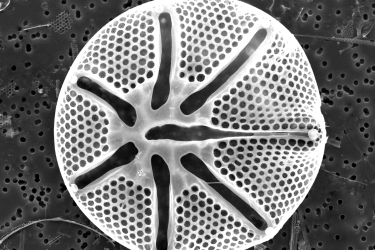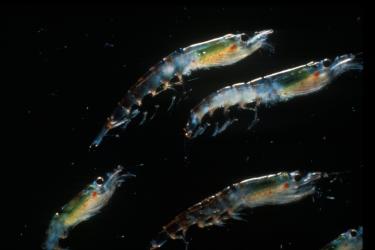The NOAA Ship Bell M. Shimada will attempt to occupy scheduled station locations between San Francisco and San Diego, California, to survey the distributions and abundances of pelagic fish stocks, their prey, and their biotic and abiotic environments in the California Current. This survey will also include an instrument comparison between the NOAA Ship Bell M. Shimada and a carbon Saildrone to compare the effectiveness of the methods in relation to each other.
April 28, 2017
The spring California Cooperative Oceanic Fisheries Investigations cruise aboard NOAA ship Bell M. Shimada sailed into San Francisco on April 20, 2017. All 104 stations were occupied thanks to the great crew and pleasant seas. Anomalously warm water conditions continue to dominate most of the California Current area. Preliminary CTD hydrographic plots have been posted to the CalCOFI website.
The most abundant species found in the bongo, an oblique plankton tow, was the pyrosome (deep sea colonial tunicate). Most bongo tows had dozens of these fascinating animals. Pyrosomes are vertical migrators and come to the surface during the nighttime hours.
On April 15, during a California Cooperative Oceanic Fisheries Investigations station near shore to Monterey Bay, scientists from NOAA, MBARI, and JCVI collaborated in launching an AUV, the first-ever effort of its kind on a CalCOFI cruise. Shipboard CTD cast and plankton tows were be used to ground truth, or calibrate, the AUV. This field test is the first step in the possible future use of the AUV during the California Cooperative Oceanic Fisheries Investigations surveys, providing information that is often difficult to capture by traditional ship-board monitoring. The AUV provides an autonomous, adaptive biological sampling of seawater over weeks-long missions to assess aquatic environments for biological constituents for a variety of applications including seafood and swimming safety, determination of productivity, and assessment of environmental integrity.
April 21, 2017
Internet access onboard the NOAA Ship Bell M. Shimada went down soon after the vessel's departure, making communications difficult while the survey was underway. A synopsis will be provided at the end of the cruise to cover the details of the survey.
April 7, 2017
The NOAA ship Bell M. Shimada departed San Diego on March 28, 2017, to begin the 2017 Spring California Cooperative Oceanic Fisheries Investigations and Saildrone Ground Truthing cruise. Operations have been smooth despite some rough seas. Sea surface temperatures hover around 16.0 ⁰C even in the California current where spring temperatures typically average 13.0 ⁰C. El Nino conditions seem slow to dissipate. Other signs that indicate the persistent warm temperatures are the pelagic red crabs (Pleurocodes planipes) and By-The-Wind-Sailors (Velella velella) captured in the Bongo and Manta nets. CUFES (Continuous Underway Fish Egg Sampler) has been dominated by anchovy (Engraulis mordax) eggs near shore. One sample is estimated to contain an impressive 750+ eggs in a 20 minute sample. Anchovy egg abundance in CUFES has increased dramatically from 2016 and is corroborated with catches of both eggs and adults on the NOAA Ship Rueben Lasker Spring Coastal Pelagic Species Cruise (underway now). A grand total of three sardine (Sardinops sagax) eggs were collected in CUFES thus far, all offshore.

